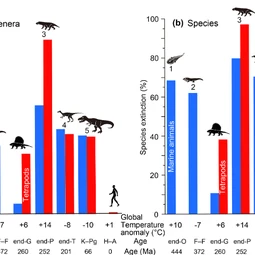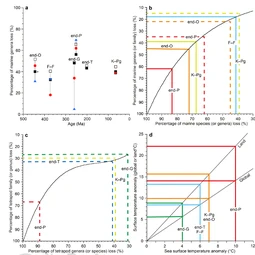The bigger the temperature change, the larger the extinction event, reveals researcher
22 July 2022
MUNICH – A professor emeritus at Tohoku University has unearthed evidence that points to a strong relationship between the magnitude of mass extinctions and global temperature changes in geologic times. The research was published today in the European Geosciences Union journal Biogeosciences.
Abrupt climate change, accompanied by environmental destruction from large volcanic eruptions and meteorites, has caused major mass extinctions throughout the Phanerozoic Eon, covering 539 million years to the present.
To date, there have been few quantitative evaluations of the relationship between land temperature anomalies and terrestrial animal extinctions. Moreover, marine animals and terrestrial animals have experienced divergent extinction rates, and this phenomenon remains under-explored.
In this new study, Professor Emeritus Kunio Kaiho has shown that marine invertebrates and terrestrial tetrapods’ extinction rates corresponded to deviations in global and habitat surface temperatures, regardless of whether it was cooling or warming. Loss of species during the ‘big five’ major extinctions correlated with a > 7°C global cooling and a > 7–9°C global warming for marine animals, and a > 7°C global cooling and a > ~7°C global warming for terrestrial tetrapods.
“These findings indicate that the bigger the shifts in climate, the larger the mass extinction,” Kunio said. “They also tell us that any prospective extinction related to human activity will not be of the same proportions when the extinction magnitude changes in conjunction with global surface temperature anomaly.”
Kunio cites an earlier study, which claimed a 5.2°C temperature increase in average global temperature would result in a mass extinction event comparable to previous ones. Yet, based on this study’s analysis, the temperature will need to change by 9° C, and this will not appear until 2500 in a worst-case scenario.
“Although predicting the extent of future extinctions is difficult because causes will differ from preceding ones, there is sufficient evidence to suggest that any forthcoming extinction will not reach past magnitudes if global surface temperature anomalies and other environmental anomalies correspondingly change,” Kunio explains.
Kunio also found a lower tolerance for terrestrial tetrapods than marine animals for global warming events. However, marine animals had a smaller tolerance to the same habitat temperature changes than terrestrial animals. This is because the temperature anomaly on land is 2.2 times higher than sea surface temperature. These phenomena fit ongoing extinction patterns.
Looking ahead, Kunio hopes to predict future animal extinction magnitudes occurring between the period of 2000 and 2500.
More information
The European Geosciences Union (EGU) is Europe’s premier geosciences union, dedicated to the pursuit of excellence in the Earth, planetary, and space sciences for the benefit of humanity, worldwide. It is a non-profit interdisciplinary learned association of scientists founded in 2002 with headquarters in Munich, Germany. The EGU publishes a number of diverse scientific journals that use an innovative open access format and organises topical meetings plus education and outreach activities. Its annual General Assembly is the largest and most prominent European geosciences event, attracting more than 14,000 scientists from all over the world. The meeting’s sessions cover a wide range of topics, including volcanology, planetary exploration, the Earth’s internal structure and atmosphere, climate, energy, and resources. For more information, follow the EGU on Twitter and Facebook.
If you wish to receive our press releases via email, please use the Press Release Subscription Form at https://www.egu.eu/news/subscribe/. Subscribed journalists and other members of the media receive EGU press releases under embargo (if applicable) 24 hours in advance of public dissemination.
Contact
Gillian D’Souza
Media and Communications Officer
European Geosciences Union
Munich, Germany
Email media@egu.eu


